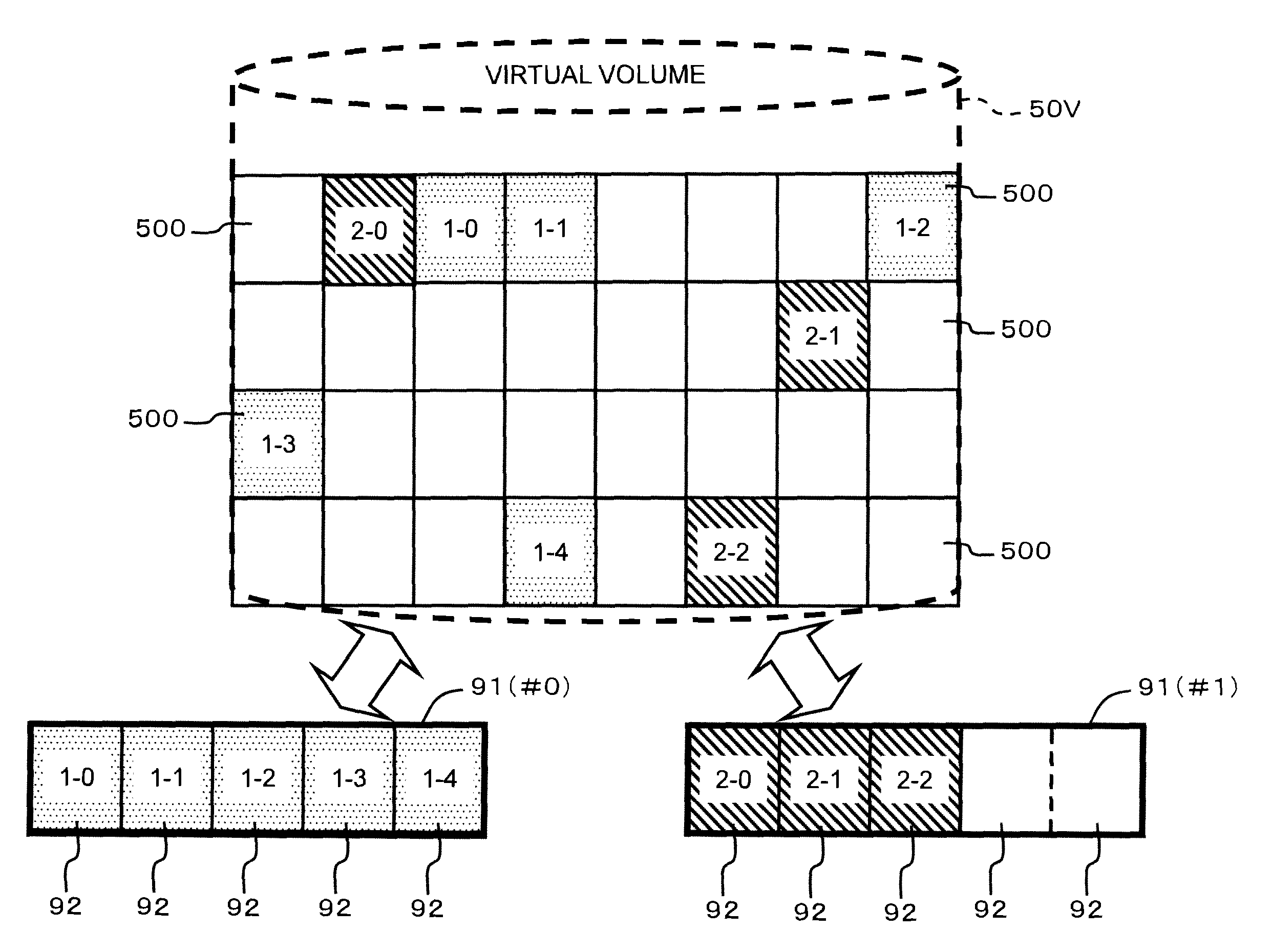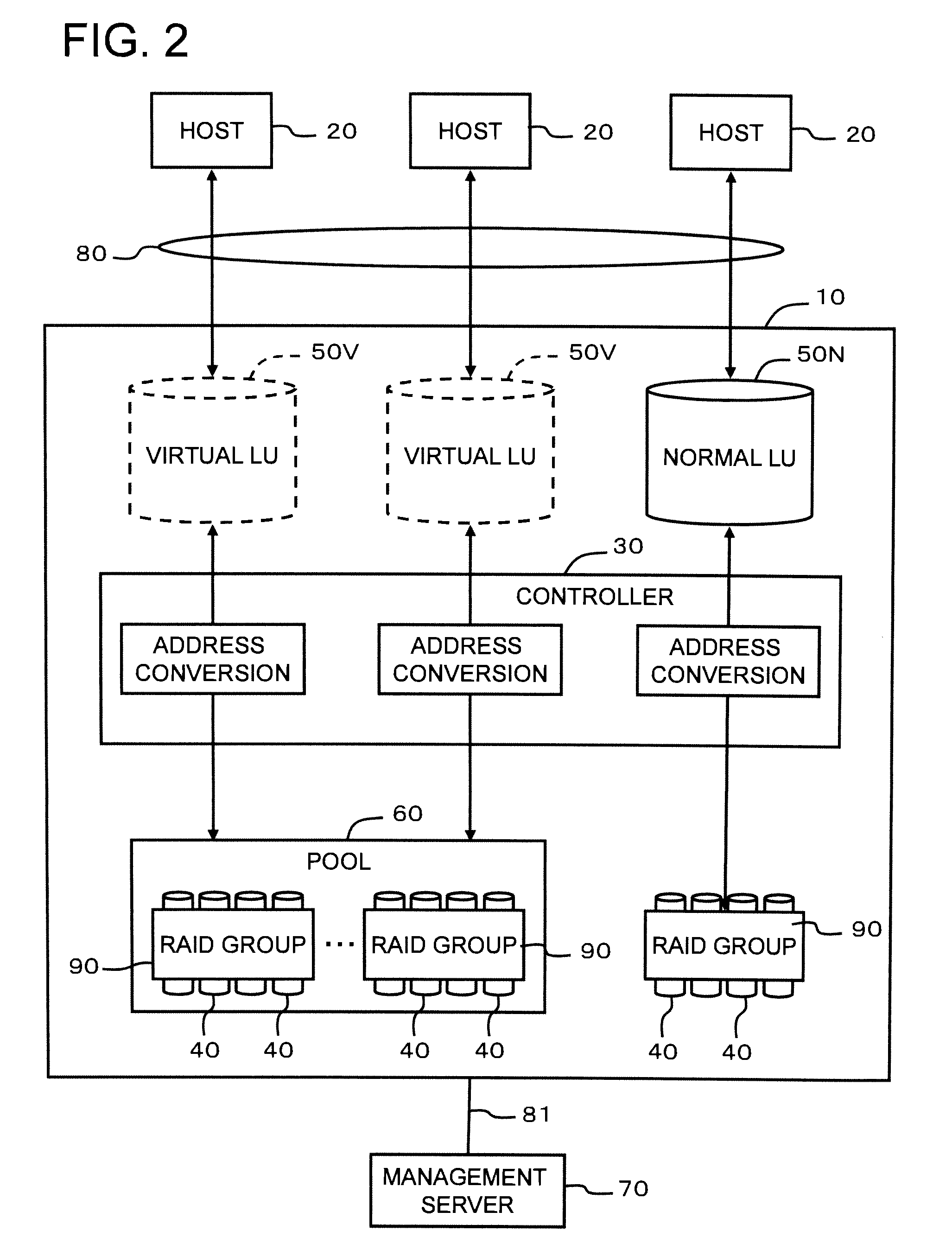Allocation and release of storage areas to virtual volumes
a control method and virtual volume technology, applied in the direction of memory address/allocation/relocation, instruments, computing, etc., can solve the problems of insufficient volume size and increased cost, and achieve the effect of efficiently improving the response performance of virtual volumes, and efficient making the correspondence of storage areas
- Summary
- Abstract
- Description
- Claims
- Application Information
AI Technical Summary
Benefits of technology
Problems solved by technology
Method used
Image
Examples
example 1
[0075]FIG. 2 is a schematic view showing the entire configuration of the information processing system including the storage control device 10 related to this example. This information processing system can be configured of, for example, at least one storage control device 10, one or more hosts 20, and at least one management server 70.
[0076]The correspondence relationship with the embodiment described with reference to FIG. 1 is described below. The storage control device 10 corresponds to the storage control device 1, a host 20 to a host 2, a controller 30 to the controller 3, a storage device 40 to the storage devices 4, virtual volumes 50V to the virtual volumes 5, and RAID groups 90 to the RAID groups 6a and 6b, respectively. The description overlapping with FIG. 1 is omitted as much as possible.
[0077]The hosts 20 and the storage control device 10 are connected to each other via a first communication network 80. The first communication network 80 is configured as, for example, ...
example 2
[0186]The second embodiment is described with reference to FIGS. 25 to 27. The other embodiments including this embodiment refer to the first embodiment. Therefore, the description below is made focusing on the differences from the first embodiment. This embodiment refers to the case where copy is performed among multiple virtual volumes 50VP and 50VS in the storage control device 10.
[0187]FIG. 25 is a schematic view showing the overall configuration of the system by this embodiment. The storage control device 10 of this embodiment includes multiple virtual volumes 50VP and 50VS. One virtual volume 50VP is a primary volume, and the other virtual volume 50VS is a secondary volume. In the description below, there are cases where they are referred to as a virtual primary volume 50VP (or a copy source volume) and a virtual secondary volume 50VS (or a copy destination volume).
[0188]The virtual primary volume 50VP and the virtual secondary volume 50VS form a copy pair, and are controlled ...
example 3
[0207]A third embodiment is described below with reference to FIG. 28. In this embodiment, the processing-completion-waiting chunk queue Q20 and the unallocated chunk queue Q30 are prepared for each RAID group, and chunks 91 are removed from each RAID group 90 in the specified order and used.
[0208]In the first embodiment, as shown in FIG. 12, only one unallocated chunk queue Q30 is prepared, and the formatted chunks in the RAID groups 90 are enqueued to the unallocated chunk queue Q30 in the specified order.
[0209]As mentioned above, in accordance with the write access to the virtual volume 50V, unused chunks 91 are selected from the unallocated chunk queue Q30 and allocated to the virtual volume 50V. Therefore, if one host 20 uses only one virtual volume 50V, chunks 91 in each RAID group 90 are serially allocated to the virtual volume 50V, and the load is evenly distributed among the RAID groups 90.
[0210]Meanwhile, if multiple hosts 20 use different virtual volumes 50V respectively,...
PUM
 Login to View More
Login to View More Abstract
Description
Claims
Application Information
 Login to View More
Login to View More - R&D
- Intellectual Property
- Life Sciences
- Materials
- Tech Scout
- Unparalleled Data Quality
- Higher Quality Content
- 60% Fewer Hallucinations
Browse by: Latest US Patents, China's latest patents, Technical Efficacy Thesaurus, Application Domain, Technology Topic, Popular Technical Reports.
© 2025 PatSnap. All rights reserved.Legal|Privacy policy|Modern Slavery Act Transparency Statement|Sitemap|About US| Contact US: help@patsnap.com



